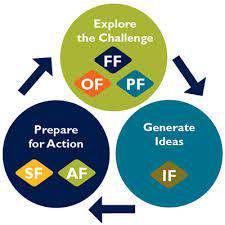CPS is one of the most effective methods of finding solutions to various problems. The approach relies on creativity and imagination to generate reliable and accurate ideas (Treffinger, Isaksen & Stead-Doval, 2005). This study addresses various CPS components using a case study on production problems in organizations.
Case Description
Production issues are some of the common problems that affect the performance and growth of organizations. The most important thing for organizations in solving production failures is the adoption of an effective problem-solving approach. To solve production problems, it is important to adopt a problem-solving model that identifies causes, impacts, and solutions (Saksen, 2008).
Necessary Data for the Case
When solving the production problems in an organization, the data involved will be obtained by identifying all the facts that are associated with the problem. The following questions will provide the relevant information needed for the problem.
- What is involved?
- Where do production problems occur?
- Who is involved in production problems?
- What causes production problems?
- When will the production problem occur?
- How does the problem occur?
- What are some of the examples of production problems?
In addition to the questions, it is important to identify additional information that is related to the problem. The main idea in the data finding stage is to obtain all the facts that are relevant to the problem. After data generation, divergent thinking can be applied to brainstorm and then apply convergent thinking to evaluate the selected facts (Saksen, 2008).
Problem Statement
Production problems in organizations should be solved in a creative and cost-effective manner. The most important thing in the problem statement is to embrace the fact there is a problem that needs to be solved (Saksen, 2008). This is then followed by the identification of sources, the impacts of the problem, and how the problem can be solved. It is also imperative to evaluate the adopted resolutions before implementation (Treffinger, Isaksen & Stead-Doval, 2005).
CPS Model Steps and Tasks
The CPS model involves exploration of the problem, generation of ideas, and preparation of an action plan. The model outlines all the processes and steps involved in solving problems as shown in the diagram (Saksen, 2008).

Problem exploration is the first step which involves identifying examples, effects, or results of a production problem. In idea generation, divergent thinking is applied to identify possible ideas that can help in solving production problems. It can entail problem and cause association, for instance, if production problems result from power failure, then solutions to solve power failure can be identified which takes about 2 to 5 hours depending on the complexity of the problem (Saksen, 2008). Preparation of an action plan involves ranking the ideas that can be used to solve production problems. For instance, in addition to power failure, idleness, strikes can be evaluated to identify the problems that are closely related to the issue at hand. The last stage is acceptance finding, which involves taking action on the identified cause of the problem (Treffinger, Isaksen & Stead-Doval, 2005)
Opportunities Available in the Process
The first stage has opportunities that include identification of the goals, collection of relevant data, and clarification of the problem. The second stage involves brainstorming to generate ideas, which can be used in solving production problems. The last stage entails the selection and strengthening of solutions using the generated ideas and opportunity to plan before implementing the action (Treffinger, Isaksen & Stead-Doval, 2005).
Important Questions
- Was the model effective?
- Was there an alternative model?
- Was the problem solved?
References
Saksen, S. (2008).Creative problem solving: The basic course. New York. Bearly Limited.
Treffinger, D., Isaksen, S., & Stead-Doval, B. (2005). Creative problem solving: an Introduction. New York, Prufrock Press.